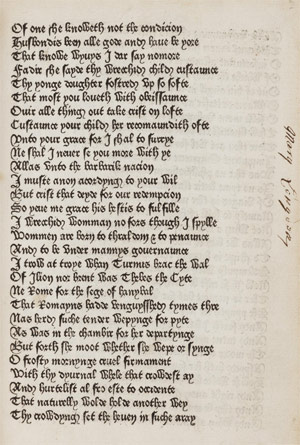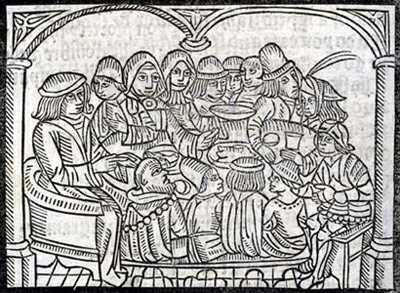The Canterbury Tales:
BASIC FACTS:

Title: The Canterbury Tales.
Author: Geoffrey Chaucer.
Date of composition: Around 1387-1400.
Date of publication: Sometime in the early fifteenth century.
Setting(s): The Tabard Inn; the road to Canterbury.
Language/dialect: Middle English.
Genre: Narrative collection of poems.
Type of narrator: The primary narrator is an anonymous member of the pilgrimage, who is not described. The other pilgrims narrate most of the tales.
Subgenres: Character portraits, parody, satire, chivalric romance, fabliaux, low comedy, exemplum, Arthurian romance, beast fable.
Plot summary:
GENERAL PROLOGUE:
The narrator opens the General Prologue with a description of the return of spring and also comments that around this time of year, people want to go on a pilgrimage. The narrator says that he is preparing to go to Saint Thomas Becket’s shrine at Canterbury and this is why he is staying at the Tabard Inn. Here, the narrator finds 29 travelers who are also doing the same pilgrimage, so he asks them if he can go along with them and they agree. In the Prologue, Chaucer declares his intention of describing each traveller considering their “condition”, their “array” and their “social degree”.
THE KNIGHT’S TALE:
The tale told by the knight is a romance set in Greece. Theseus, the King of Athens, after a battle against Creon, a tyrant of Thebes, captures two prisoners of war, Arcite and Palamon. Both of them are imprisoned and both fall in love with Emily, Hippolyta’s sister.
Arcite is liberated and returns with a disguise to court Emily and Palamon escapes from prison. Both of them meet in the woods and fight over the love of Emily. Theseus decides to let them fight and prepares shrines to Mars, Venus and Diana. Arcite prays to Mars, asking for help to win the battle, Palamon prays to Venus asking to marry Emily and Emily prays to Diana, asking not to be forced to marry. Finally, Arcite wins the battle but his horse throws him over and he dies. Before dying, he tells Palamon to marry Emily.
THE MILLER’S TALE:
The tale is a fabliaux, a short humorous narrative genre involving common people, coarse language and of a great realism. John is an old and jealous carpenter who is married to a much younger wife, Alison. John has a young clerk named Nicholas who lives with the couple and is in love with Alison. Absolon, the parish clerk, also is in love with Alison, but his attempts to woo her are in vain because she is only interested in Nicholas.
One day, Nicholas tricks John into thinking that Noah’s flood is coming and John makes three tubs, in which Nicholas, Alison and he can float until the waters recede. When the flood is due, the three of them hide in the tubs but then Alison and Nicholas go to the bedroom. There, they are interrupted by Absolon calling at the window. Alison promises him a kiss but she puts her backside to the window instead of her cheek. He realises this, gets a hot coulter from the smith and returns another time asking for a kiss. This time it is Nicholas who puts his backside out and Absolon strikes him with the hot coulter. Nicholas starts to cry for water and John awakes thinking that the flood has arrived. He cuts his tub loose and falls from the roof.
THE WIFE OF BATH’S TALE:
The Wife of Bath tells a story about a knight of the Arthurian times who rapes a young maiden. The King condemns him to death, but the Queen decides to release him if he can tell her what women most desire. The knight is given a year to find out the answer.
After spending a lot of time trying to figure out the answer, he explains his problem to an old hag who tells him that she has the solution. However, as a reward for telling him what women most desire, he must marry her. The knight accepts the offer and returns to the castle. There, the Queen asks him for the answer again and the knight tells her that what women most desire is sovereignty over their husbands. All the women present agree that this is the correct answer and the knight is forgiven.
On their wedding night, the old woman is very upset because her husband is ignoring her, so she asks him what he would prefer, an old and ugly woman who is loyal or a beautiful but unfaithful woman. He answers that she should choose. She was so happy and pleased with the answer that she tells him to kiss her. This kiss turns her into a beautiful woman.
FURTHER INFORMATION:
Major themes:
Courtly love
Courtly love is a classic literary genre. Courtly love is only practiced between a man and a woman of noble status, like a knight or squire. The man and woman cannot be husband and wife because this kind of love is ideal and such relationships did not exist in medieval marriages. This love is passionate and disciplined. The most important example of courtly love is found in the knight’s tale. Geoffrey Chaucer takes courtesy back to ancient Greek epic times. The characters in the tale are of noble status and represent the best and most ideal of their estate. These characters are also represented as pawns of divine forces and victims of chance. Arcite and Palamon are flat characters with no personality; they always beseech the divine aid of gods to help them, for example, Arcite prays to Mars to win the battle. Finally, we can say that these characters behave towards the lady with courtesy and devotion.

Importance of company
The vast majority of Chaucer’s characters finish their tales wishing the rest of the company well. For example, the Knight says: “God save al this faire compaignye” (3108). It is important to be a part of a group because if you don’t have a group, you can face difficulties. The company of pilgrims on the way to Canterbury is composed of people from various parts of England and also from different parts of society, for example we can find people from the court, the Church, villages and the country. To describe them, Chaucer follows the medieval pyramid, so they are described from the highest “class” to the lowest “class” in society.
Corruption of the Church and exceptions:
Chaucer criticizes problems of his time through irony. With the descriptions of the nun, the friar and the monk, we have satires of religious figures who are supposed to live a monastic life of deprivation and hard work, but instead live a life of luxury and ease. On the other hand, Chaucer also introduces two characters, the parson and the plowman, who live the gospel and teach by being virtuous and holy in all things. They are presented as perfect people with Christian ideals. The parson’s presence on the pilgrimage is necessary because without him, we have no idea of what a religious figure ought to be, while with him, we have an almost Christ-like figure.
Main characters:
The Knight: This is the first pilgrim Chaucer describes in the Prologue, and the teller of the first tale. He represents the highest status in the company. Chaucer describes this character in a positive way: worthy man. He is brave, experienced, and prudent with everybody; the narrator admires him. He has been everywhere (in the Crusades, he has also battled the Muslims in Egypt, Spain, and Turkey). The Knight is forty years old more or less. He wears a tunic made of coarse cloth, and his coat of mail is rust-stained, because he has recently returned from an expedition. Chaucer says that he is excellent but not “gaily dressed”.
The Wife of Bath: Chaucer says that she is a good worker and her behaviour on Sundays in Church is correct. She has travelled all over the world on pilgrimages. She is vain, domineering, lustful and proud. She is not shy and knows her rights and in this sense, she is a very modern woman. One interesting thing is her attitude towards marriage. She has married five times, and twice with men much older than her. She is therefore well-practiced in the art of love. She presents herself as someone who loves marriage and sex. Moreover, she is deaf in one ear and has a gap between her front teeth, which was considered an attractive feature in Chaucer’s time. Finally, we can say that the wife of Bath represents the medieval state of wifehood.
The Miller: He is a large man with an imposing figure, making him seem more powerful than the other characters. This character has a red beard and hair. He also has a rude and corrupt attitude, treating his fellow travellers with contempt. He is shameless and selfish, and has a bad temper. He tells a tale about a student who plans to have an affair with the wife of an old, jealous and foolish carpenter, showing his immaturity and pleasure in other people's misery. This character can be seen as very realistic.

Symbols:
Springtime: The Canterbury Tales opens in April, at the height of Spring. The springtime symbolises rebirth and fresh beginnings. Springtime also evokes erotic love. It is around this time of year, the narrator says, that people begin to feel the desire to go on a pilgrimage.
Clothing: In the General Prologue, the description of garments helps to define each character. In a sense, clothes symbolise what lies beneath the surface of each personality. For example, the Squire’s youthful vanity is symbolised by the excessive floral brocade on his tunic.
Literary devices:
All but two of the Canterbury Tales are written in prose. The meter varies although many lines are in iambic pentameter. The prologue and the tales of the pilgrims consist of a series of rhyming couplets (units of two lines, each about the same length, with end rhyme).
Rhyme scheme:
1 Whan that Aprille, with hise shoures soote,
2 The droghte of March hath perced to the roote
3 And bathed every veyne in swich licour,
4 Of which vertu engendred is the flour;
Irony: Chaucer criticises problems of his time through irony. One major irony is Chaucer’s representation of the religious figures, who are supposed to be holy and virtuous people but are actually corrupt and break their vows. Chaucer uses a lot of verbal irony when talking about them, saying that they are “models” in a sarcastic fashion.
Coupling technique: Chaucer pairs the characters such as knight/squire, monk/friar, parson/plowman, summoner/pardoner.
Satire: In the tales there are plenty of examples of satire. Satire is a much harsher device than irony and Chaucer uses it in the Canterbury Tales to expose his attitude towards the Catholic Church of the Middle Ages.



